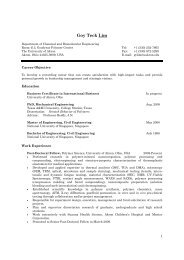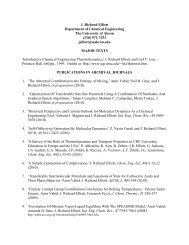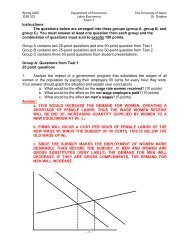Sociology of the Anarchists - Gozips.uakron.edu - The University of ...
Sociology of the Anarchists - Gozips.uakron.edu - The University of ...
Sociology of the Anarchists - Gozips.uakron.edu - The University of ...
You also want an ePaper? Increase the reach of your titles
YUMPU automatically turns print PDFs into web optimized ePapers that Google loves.
Labor Movement and New Social Movements 53<br />
North American anarchist organizations—groups that espouse an anarchist philosophy—<br />
may arguably be best understood by Fitzgerald and Rodgers’ (2000) model <strong>of</strong> radical<br />
social movement organizations (RSMOs), which differ from moderate social movement<br />
organizations in terms <strong>of</strong> organizational structure, ideology, tactics, communication, and<br />
assessment <strong>of</strong> success. RSMOs are thus nonhierarchical, participatory, egalitarian, and<br />
radical, emphasize structural change, use nonviolent action and innovative tactics, are<br />
ignored and misrepresented by <strong>the</strong> mainstream media, utilize alternative media, use<br />
limited resources, and are subject to intense opposition and surveillance. This model<br />
modifies <strong>the</strong> framework set by resource mobilization <strong>the</strong>ory (McCarthy and Zald 1977)<br />
by arguing that bureaucratization and institutionalization <strong>of</strong> social movements is not<br />
always necessary or inevitable.<br />
However, for this study, I will use <strong>the</strong> more widely-known new social movements (NSM)<br />
<strong>the</strong>ory, since it <strong>of</strong>fers <strong>the</strong> best vantage point to challenge <strong>the</strong> <strong>of</strong>t-claimed notion that <strong>the</strong><br />
anarchist movement is <strong>of</strong> <strong>the</strong> middle-class or that it is not active in class-related issues. It<br />
also speaks more directly to <strong>the</strong> individual characteristics <strong>of</strong> movement participants ra<strong>the</strong>r<br />
than <strong>the</strong> organizational structures <strong>the</strong>y utilize.<br />
NSM <strong>the</strong>ory asserts that in this era <strong>of</strong> post-industrialism, modern social movements differ<br />
from earlier movements, and focus upon less-class-oriented issues such as racial equality,<br />
feminism, peace, <strong>the</strong> environment, and localist issues. In North America, non-classoriented<br />
franchise anarchistic organizations that fall into <strong>the</strong>se categories include ACT-<br />
UP, Anti-Racist Action, Animal Liberation Front, Critical Mass, Earth First!, Earth<br />
Liberation Front, Food Not Bombs, and Reclaim <strong>the</strong> Streets. As such, Cohen (1985)<br />
argues that “Unlike <strong>the</strong> Old Left, actors involved in contemporary movements do not<br />
view <strong>the</strong>mselves in terms <strong>of</strong> a socioeconomic class” (p. 667).<br />
Offe (1985) states that NSMs differ from traditional social movements by focusing on<br />
values <strong>of</strong> autonomy and identity, organizing with decentralization, self-government, and<br />
self-help in mind, and tend to be ad hoc, egalitarian, and non-hierarchical—incidentally<br />
strong anarchist values. Because problems related to authority and domination may be<br />
found within multiple domains, anarchists are unique in <strong>the</strong>ir relation to NSMs. <strong>The</strong>re is<br />
considerable cross-movement participation within all <strong>the</strong> aforementioned movements by<br />
anarchists and <strong>the</strong>ir organizations (Epstein 1991, Graeber 2002, Shantz 2003).<br />
Sheppard (2002) claims, albeit without quantitative analysis, that anarchists are less likely<br />
to organize and belong to unions than in <strong>the</strong> past, and that <strong>the</strong>y instead choose to find<br />
o<strong>the</strong>r work if <strong>the</strong>ir current job is disagreeable. Sheppard hypo<strong>the</strong>sizes this is because <strong>of</strong><br />
<strong>the</strong> aforementioned class collusion <strong>of</strong> modern unions, macho stereotypes <strong>of</strong> unions, and<br />
<strong>the</strong> punk subculture <strong>of</strong> rejection that contemporary anarchism draws heavily from. He<br />
opines that, “Young anarchists <strong>of</strong>ten correctly see <strong>the</strong> organized labor movement as not<br />
radical at all, but as a backwards force embodying <strong>the</strong> worst kinds <strong>of</strong> provincialism and<br />
political maneuvering” (para. 6). His generalizations appear to support classifying<br />
53 This section is partially composed <strong>of</strong> relevant portions <strong>of</strong> a literature review from a graduate course<br />
entitled <strong>Sociology</strong> 753: Secondary Data Analysis, at <strong>the</strong> <strong>University</strong> <strong>of</strong> Akron, Summer 2004.<br />
[ Williams 57 ] [ this is a draft. do not cite. ]






